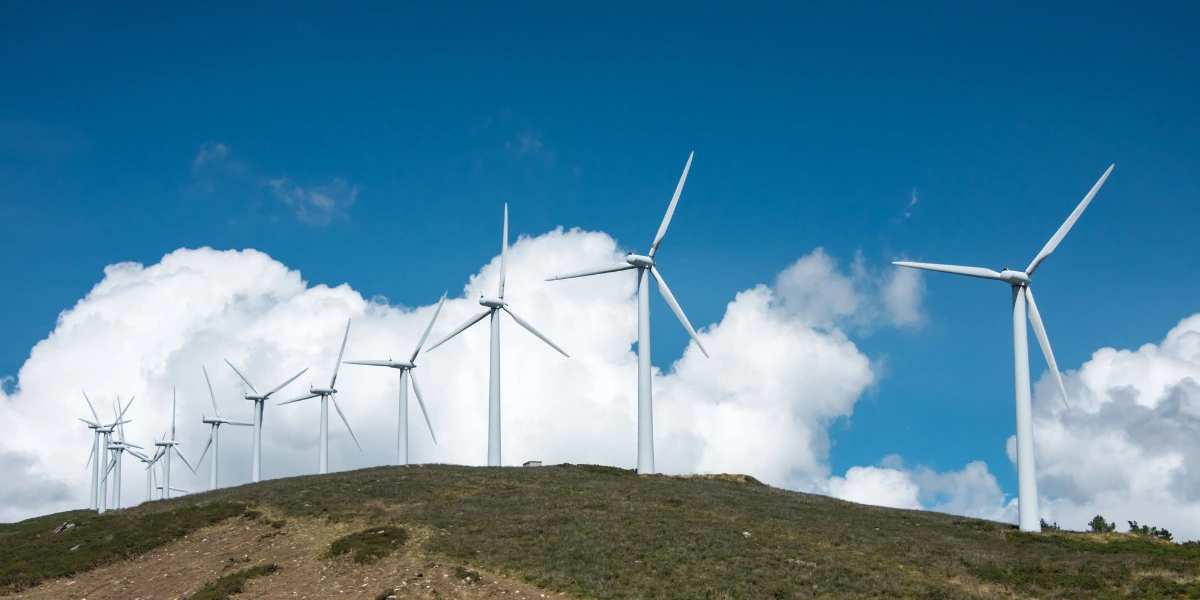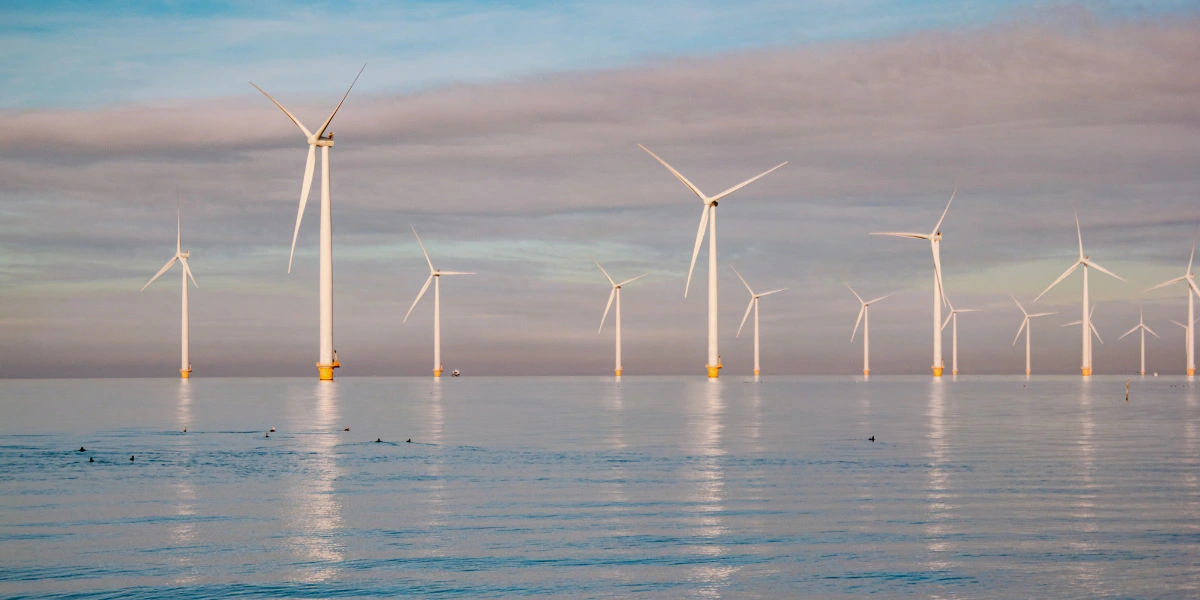Table of Contents
What’s the difference between Offshore wind vs onshore wind? Offshore wind farms are located in bodies of water and benefit from stronger, more consistent winds, whereas onshore wind farms are situated on land and are generally easier and cheaper to construct and maintain.
According to Blackridge's Global Wind Turbine Market Outlook, 2024-2030 global wind growth forecast (1210GW) upwards by 10%. This is due to the establishment of national industrial policies and offshore wind market growth in recent years.
In 2023, global wind power capacity surpassed 1 TW and adding next 1 TW is expected in just 7 years. Onshore wind power is experiencing a remarkable 54% year-over-year growth by adding 106 GW. Meanwhile, offshore wind saw a 24% increase, adding 10.8 GW, totaling 75.2 GW globally.
Wind energy is an important powerhouse for a sustainable future. However, not all wind farms are created equal. Understanding the difference between onshore and offshore wind farms is necessary, as each offers unique advantages and disadvantages.
Onshore Wind Farm
In simple terms, onshore wind energy can be defined as wind energy harnessed by installing wind turbines in terrestrial locations. The process consists of converting the kinetic energy into electrical energy of wind by the rotational motion of rotor blades. This energy conversion produces renewable wind electricity for residential, commercial, and industrial use.

Advantages of onshore wind farms
Now, let's delve into the notable advantages that make onshore wind farms a compelling choice for clean energy generation:
- Lower upfront costs: Onshore wind farms require simpler infrastructure, making them more cost-effective for developers.
- Faster installation and maintenance: Onshore projects can be built and maintained more quickly due to easier access and ground-based location.
- Established technology: Onshore wind turbine technology is advanced, reducing the need for specialized skills and equipment.
- Potential for community ownership: Local communities can develop and manage onshore wind farms, fostering economic benefits and community involvement.
- Flexible scale and land use: Onshore wind farms can be built in various sizes and locations, accommodating different energy needs and land availability.
Find Onshore Wind Projects and Tender Leads around the GlobeClaim Your Free Leads!
Disadvantages of onshore wind farms
While onshore wind farms offer numerous advantages, they also have certain drawbacks. Let's explore critical disadvantages to consider:
- Visual Impact: Onshore wind turbines can be visually imposing, potentially disrupting an area's natural landscape and aesthetics.
- Potential Noise Concerns: Onshore turbines generate noise as they rotate, with a possibility of low-frequency noise disturbing nearby residents.
- Environmental impact: Bird and bat collisions with onshore turbine blades pose environmental concerns, requiring careful planning and mitigation strategies.
- Land-Use Considerations: Onshore farms require significant land area, potentially competing with agriculture, recreation, or other land uses.
- Intermittency: Wind is a variable resource, leading to inconsistent power generation from onshore wind farms and necessitating backup power sources for reliability.
Read: Top Ten Wind Farms in the World
Offshore Wind Farm
Offshore wind farms harness wind power by installing wind turbines in ocean waters. Unlike onshore wind farms located on land, offshore farms are positioned offshore, often in coastal areas or further out to sea. These wind turbines are typically anchored to the seabed and utilize the strong and consistent winds found over water to generate electricity.

Advantages of Offshore Wind Farms
Offshore wind farms offer several distinct advantages:
- Stronger and Steadier Winds: Offshore locations like North Sea experience stronger and steadier offshore wind speeds, leading to higher energy efficiency and power production.
- More Giant Turbines: Deeper water depths and less restrictive space allow larger offshore wind turbines to capture more wind and generate more electricity.
- Reduced Visual Impact: Offshore wind farms are located further from populated areas, minimizing visual impact on land and preserving aesthetics.
- Potential for Lower Lifetime Costs: Despite higher upfront costs, higher efficiency, and larger offshore wind turbines can result in lower lifetime energy production costs.
Looking for Global Wind Power Market Report? Download Free Sample Now!
Disadvantages of Offshore Wind Farms
Offshore wind farms face certain drawbacks that can hinder their wider adoption. These are the disadvantages to consider:
- Higher Upfront Costs: Building in the ocean environment increases initial investment costs compared to onshore wind farms.
- Technical Challenges: Specialized equipment and expertise are required for construction, maintenance, and repairs in harsh wave conditions.
- Potential Impact on Marine Life: Offshore turbines can disrupt marine habitats and create noise pollution, requiring careful environmental assessment and mitigation.
- Limited Grid Capacity: Connecting to the electricity grid can be challenging, necessitating upgrades in regions with limited infrastructure.
Read: Top 7 Upcoming Floating Offshore Wind Projects In the World
Cost Comparison Between Onshore vs Offshore Wind Energy
| Parameter | Onshore wind | Offshore wind (Fixed-Bottom) | Offshore wind (Floating) |
| Wind turbine rating (MW) | 3 | 8 | 8 |
| Capital expenditures (CapEx) - USD /kW | 1,501 | 3,871 | 5,577 |
| Fixed charge rate (FCR) (%) | 5.88 | 5.82 | 5.82 |
| Operational expenditures (OpEx) - USD /kW/yr | 40 | 111 | 118 |
| Net annual energy production (MWh/MW/yr) | 3,775 | 4,295 | 3,336 |
| Levelized Cost of Energy (LCOE) (USD /MWh) | 34 | 78 | 133 |
Source: National Renewable Energy Laboratory
The cost of wind energy has dropped dramatically in the past decade. Onshore wind LCOE (Levelized Cost of Energy) went from USD 0.107/kWh to USD 0.033/kWh, while offshore wind went from USD 0.197/kWh to USD 0.081/kWh. Despite the higher initial cost, offshore wind farms have a higher average utilization rate (42% vs 37-38%), making them potentially more productive.
Difference between Onshore and Offshore Wind
| Feature | Onshore Wind | Offshore Wind |
| Location | Land | Ocean waters (coastal or further out to sea) |
| Wind Speed | Lower and more variable | Stronger and steadier |
| Turbine Size | Smaller (due to land restrictions) | Larger (deeper water allows for larger structures) |
| Upfront Costs | Lower | Higher (construction in ocean environment) |
| Installation & Maintenance | Faster and easier (ground-based access) | Slower and more complex (harsh sea conditions) |
| Technology | Mature and established | Requires specialized expertise |
| Visual Impact | More noticeable on land | Less visible from shore |
| Community Involvement | Easier for local communities to develop and manage | Limited community involvement |
| Land Use | Requires significant land area | Less land use impact |
| Impact on Wildlife | Bird and bat collisions a concern | Potential impact on marine life |
| Intermittency | Wind variability leads to inconsistent power generation | Steadier winds provide more consistent power generation |
| Grid Connection | Easier to connect to existing grid | May require grid upgrades in some regions |
| Potential Lifetime Cost | Lower | Potentially lower due to higher efficiency, despite higher upfront costs |
Onshore and Offshore Wind Global Trends
Onshore and offshore wind are having a positive impact on reducing dependence on fossil fuels. Many countries and stakeholders are keen to invest in wind energy. Let's look at the global trend of the wind energy market in 2024.
Onshore Wind
With a global surge in 2023, Onshore wind farms witnessed a record-shattering 106 GW of new wind capacity added to the grid, representing a remarkable 54% year-over-year growth. This marks the first time annual installations surpassed the 100 GW milestone. China and the US remain dominant players in the onshore wind market, followed closely by Brazil, Germany, and India.
These top five markets contributed 82% of all new installations globally, highlighting a concentrated growth pattern. While China reached 69 GW of added capacity, the US experienced a dip, installing only 6.4 GW – its lowest level since 2014. However, India saw a significant upswing, with a 56% increase in new installations compared to 2022. This trend suggests a promising future for onshore wind as a critical component of the world's energy mix.
Offshore Wind
The year 2022 marked the second-highest year for offshore wind projects, pushing total capacity to 64.3 GW. This momentum is expected to continue in offshore projects. Also, global wind energy council forecasts predicting 380 GW of additional capacity added over the next decade. The offshore wind energy in Asia-Pacific region is set to lead this charge, with nearly half of the projected growth.
Floating turbines are expected to contribute a significant 6% to the overall offshore wind market share. The UK added up to 4.5 gigawatts of floating offshore wind capacity, bringing significant renewable energy closer to the national grid.
This rapid expansion promises significant environmental benefits, with estimates suggesting new wind farms in the APAC region could avoid a massive 650 million tonnes of CO2 annually. However, permitting and infrastructure development bottlenecks could hinder progress outside of China. Increased investment and international cooperation will be essential to overcome these hurdles and ensure the continued success of offshore wind power globally.
Conclusion
In conclusion, both onshore and offshore wind energy present compelling solutions for sustainable wind electricity generation, each with advantages and challenges. The global trend showcases a significant expansion in both sectors, with onshore wind experiencing record-breaking growth and offshore wind ready for substantial development, particularly in the Asia-Pacific region. As we navigate towards a cleaner energy future, strategic investments, technological advancements, and international cooperation will be crucial in harnessing the full potential of wind power to mitigate climate change and ensure energy security.
Connect with decision-makers of floating offshore wind projects around the Globe for business opportunities.
Subscribe to our Global Floating Offshore Wind Farm Project and Tender Database to get access to reliable and high-quality insights on upcoming, in-progress, and completed floating offshore plant projects across the world or in your desired geographical location.
Our user-friendly platform provides essential details, timely updates, key stakeholder contact information, and business opportunities tailored for engineering companies, industry professionals, investors, and government agencies.
Start a free demo to take your business to the next level!

Leave a Comment
We love hearing from our readers and value your feedback. If you have any questions or comments about our content, feel free to leave a comment below.
We read every comment and do our best to respond to them all.